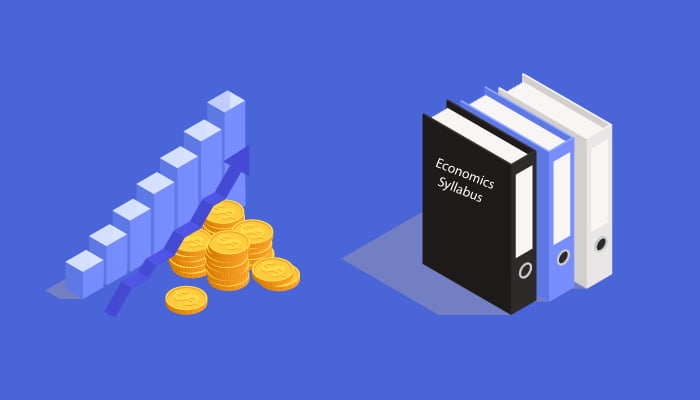Class 11 Economics Syllabus contains all connected chapters of the subjects of this Academic year. Vidya Setu provides you with the latest CBSE class 11th economics syllabus that will give you a brief idea about the chapters which are coming in your exams. Students can use this descriptive class 11 economics syllabus for March 2022 exams arranged by CBSE. And if you dedicatedly plan your preparation according to our latest class 11 economics syllabus of 2022-23 then you will definitely score good marks in your exams.
Class 11 Economics Syllabus
It is always hard to carry the physical copy everywhere so you can check the class 11 economics syllabus from our website and use it when you want.
Also, check: CBSE Class 11 Commerce Syllabus 2023-24
Suggested Question Paper Performa
| SN | Typology of Questions | Marks | Percentage |
| 1 | Remembering and Understanding: Exhibit memory of previously learned material by recalling facts, terms, basic concepts, and answers. Demonstrate understanding of facts and ideas by organizing, comparing, translating, interpreting, giving descriptions, and stating main ideas. | 44 | 55% |
| 2 | Applying: Solve problems to new situations by applying acquired knowledge, facts, techniques and rules in a different way. | 18 | 22.5% |
| 3 | Analysing, Evaluating and Creating: Examine and break information into parts by identifying motives or causes. Make inferences and find evidence to support generalizations. Present and defend opinions by making judgments about information, validity of ideas, or quality of work based on a set of criteria. Compile information together in a different way by combining elements in a new pattern or proposing alternative solutions. | 18 | 22.5% |
There will be Internal Choices in questions of 1 mark, 3 marks, 4 marks, and 6 marks in both sections (A & B). In all, a total of 8 internal choices.
CBSE Class 11 Economics Marks & Period Distribution
| Unit | Topic | Marks | Period |
| Part A | Statistics for Economics | ||
| Unit 1 | Introduction | 15 | 10 |
| Unit 2 | Collection, Organisation and Presentation of Data | 30 | |
| Unit 3 | Statistical Tools and Interpretation | 25 | 50 |
| Part B | Introductory Microeconomics | ||
| Unit 4 | Introduction | 04 | 10 |
| Unit 5 | Consumer’s Equilibrium and Demand | 15 | 40 |
| Unit 6 | Producer Behaviour and Supply | 15 | 35 |
| Unit 7 | Forms of Market and Price Determination under perfect competition with simple applications | 06 | 25 |
| Total | 40 | 200 | |
| Part C | Project work | 20 | 20 |
Guidelines for Project Work in Class 11 Economics
The goals of the undertaking work are to empower students to:
- Test further into hypothetical ideas learned in classes and XI
- Dissect and assess certifiable financial situations utilizing hypothetical builds and contentions
- Show the learning of the financial hypothesis
- Follow up parts of financial matters in which students have an interest
- Foster the relational abilities to contend intelligently
The assumptions for the venture work are that:
- Students will finish just ONE venture in every scholastic meeting
- The undertaking ought to be of 3,500-4,000 words (barring outlines and diagrams), ideally manually written
- It will be an autonomous, self-coordinated piece of study
The Job of the Instructor: The educator assumes a basic part in fostering the thinking abilities of the students. An educator has to:
- Assist every student with choosing the theme dependent on late distributed concentrates from the news media, government arrangements, RBI notice, NITI Aayog reports, IMF/World Bank reports, and so forth, after definite conversations and consultations of the subject.
- Assume the part of a facilitator and chief to screen the venture work of the student through intermittent conversations.
- Guide the examination work as far as hotspots for the significant information.
- Instruct students about literary theft and the significance of citing the wellspring of the data to guarantee the legitimacy of exploration work.
- Set up the student for the introduction of the undertaking work.
Download PDF of Class 11 Economics Syllabus
Final Words
With this latest class 11 economics syllabus, you will gather excellent marks from any school or college if you follow the guidelines and principles described in the article. Do not bother with your career prospects Vidya Setu, Jaipur is there to study and learn for the Class 11 & 12 examinations. And one more thing, don’t forget to tell your opinion about this class 11 economics syllabus in the comment section below.

